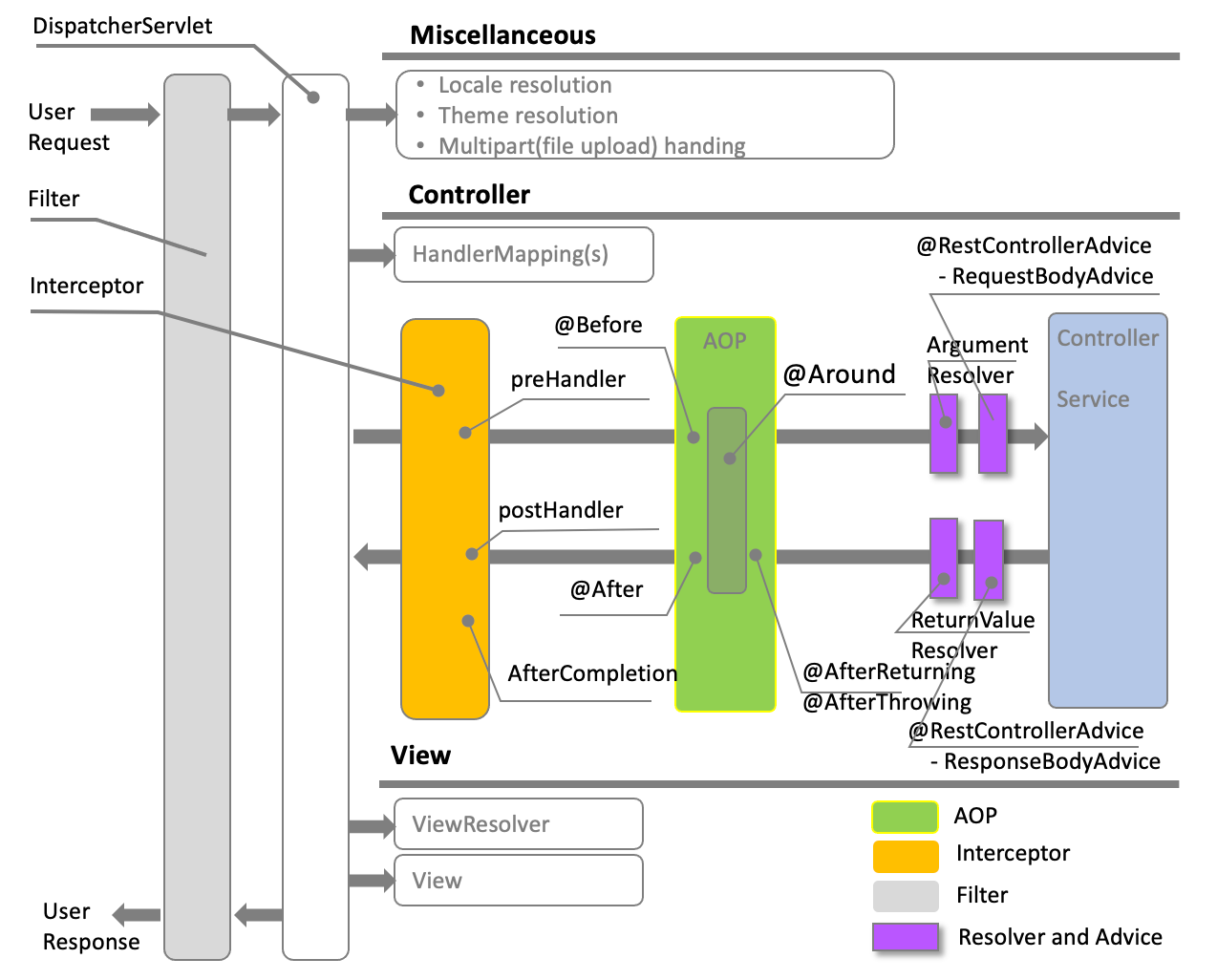Http 요청을 복호화하여 Controller에 전달하기 - RequestBodyAdvice
화
RequestBodyAdvice
Http Request를 제어 또는 가공(Decrpt)할 수 있는 또 하나의 영역중 하나가 바로 RequestBodyAdvice 입니다. ArgumentRoslver는 RestController에는 약간의 제약사항이 있으나 RequestBodyAdvice는 그러한 제약사항이 없습니다. 적용하는 방법은 ArgumentResolver와 유사하고 점도 섬세한 제어가 가능합니다.

RequestBodyAdvice를 상속받아 구현
Http 요청을 했을 때 body 데이터를 제어하고자 할 떄 RequestBodyAdvice를 상속받아 아래와 같이 3개의 Method를 구현해야 합니다.
- public boolean supports(…)
- public HttpInputMessage beforeBodyRead(…) throws IOException
- public Object afterBodyRead(…)
supports에서는 대상 Controller나 대상 Parameter Type에 따라 대상을 선택할 수 있습니다.
beforeBodyRead 는 Http Body를 읽기전에 처리하거나 afterBodyRead 는 Http Body를 읽은후에 처리합니다.
beforeBodyRead에서는 inputMessage의 getHeader와 getBody를 읽어서와 원하는 작업을 할 수 있수 있습니다.
afterBodyRead는 Controller의 Input Type을 body로 넘어오며 그것을 가공할 수 있습니다.
RequestBodyAdvice - 예시
아래의 예제는 RequestBodyAdvice를 구현한 DecryptRequestBodyAdvice입니다.
import java.io.ByteArrayInputStream;
import java.io.IOException;
import java.io.InputStream;
import java.lang.reflect.Type;
import java.nio.charset.StandardCharsets;
import org.springframework.core.MethodParameter;
import org.springframework.http.HttpHeaders;
import org.springframework.http.HttpInputMessage;
import org.springframework.http.converter.HttpMessageConverter;
import org.springframework.web.bind.annotation.RestControllerAdvice;
import org.springframework.web.servlet.mvc.method.annotation.RequestBodyAdvice;
import com.demo.microservices.controller.UserController;
import com.demo.microservices.util.AESUtil;
import com.demo.microservices.util.IOUtils;
import lombok.extern.slf4j.Slf4j;
@Slf4j
@RestControllerAdvice
public class DecryptRequestBodyController implements RequestBodyAdvice {
private String decodingBody;
private byte[] rawData;
@Override
public boolean supports(MethodParameter methodParameter, Type targetType,
Class<? extends HttpMessageConverter<?>> converterType) {
log.info("------------ DecryptRequestBodyController ------------ ");
log.info("supports:{}", methodParameter.getContainingClass().equals(UserController.class));
return methodParameter.getContainingClass().equals(UserController.class);
}
@Override
public HttpInputMessage beforeBodyRead(HttpInputMessage inputMessage, MethodParameter parameter, Type targetType,
Class<? extends HttpMessageConverter<?>> converterType) throws IOException {
log.info("------------ beforeBodyRead ------------ ");
HttpHeaders headers = inputMessage.getHeaders();
AESUtil aesUtil = new AESUtil();
try {
InputStream inputStream = inputMessage.getBody();
rawData = IOUtils.toByteArray(inputStream);
decodingBody = aesUtil.decrypt(new String(rawData, StandardCharsets.UTF_8));
log.info("decodingBody:{}", decodingBody);
} catch (IOException e) {
e.printStackTrace();
}
return new DecodeHttpInputMessage(headers, new ByteArrayInputStream(decodingBody.getBytes()));
}
@Override
public Object afterBodyRead(Object body, HttpInputMessage inputMessage, MethodParameter parameter, Type targetType,
Class<? extends HttpMessageConverter<?>> converterType) {
log.info("------------ afterBodyRead ------------ ");
log.info("body:{}", body);
return body;
}
@Override
public Object handleEmptyBody(Object body, HttpInputMessage inputMessage, MethodParameter parameter,
Type targetType, Class<? extends HttpMessageConverter<?>> converterType) {
log.info("handleEmptyBody ", targetType);
log.info("body:{}", body);
log.info("targetType:{}", targetType);
return body;
}
}
DecodeHttpInputMessage.java 파일입니다.
import java.io.IOException;
import java.io.InputStream;
import org.springframework.http.HttpHeaders;
import org.springframework.http.HttpInputMessage;
public class DecodeHttpInputMessage implements HttpInputMessage {
private HttpHeaders headers;
private InputStream body;
public DecodeHttpInputMessage(HttpHeaders headers, InputStream body) {
super();
this.headers = headers;
this.body = body;
}
@Override
public HttpHeaders getHeaders() {
// TODO Auto-generated method stub
return headers;
}
@Override
public InputStream getBody() throws IOException {
// TODO Auto-generated method stub
return body;
}
}
댓글남기기